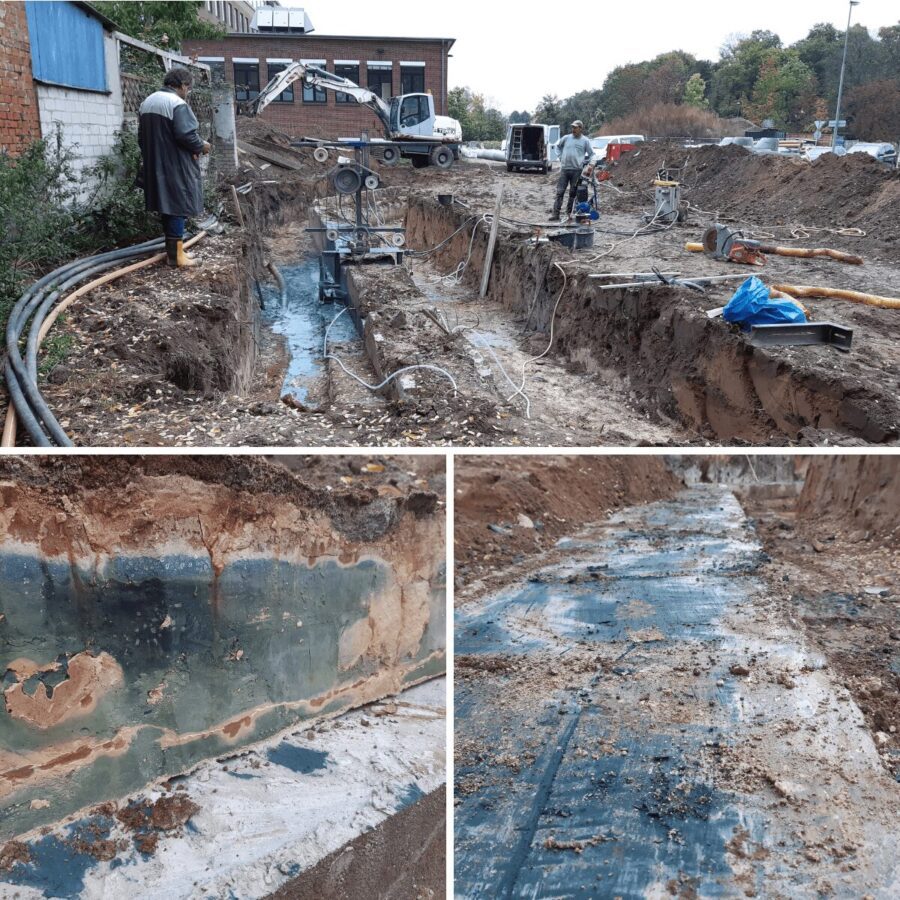When remediating and securing contaminated sites, so-called cut-off walls are used to encapsulate and shield the contaminated soil area in the groundwater-saturated zone as a hydraulically low-permeability vertical barrier. The inflowing groundwater can thus no longer pass through the quasi-impermeable cut-off wall and is diverted around the contaminated site. Similarly, contaminated water from the area enclosed by the cut-off wall can no longer reach the outside, form a contaminant plume and contaminate groundwater or surface water further downstream.
Method and material Single-phase sealing wall
Cut-off walls are usually constructed in a thickness of 60 cm or 80 cm using the single-phase diaphragm wall method and can theoretically reach depths of up to 100 m below ground level. The base of the cut-off wall ties into the impermeable, usually silty to clayey aquifer to prevent underflow. The cut-off wall slot is excavated in sections in lamellas using the contractor method, and a supporting slurry is used to prevent the laterally accumulating subsoil from falling or sliding into the slot. Lateral concrete guide walls arranged on the surface provide precise guidance for the metre-high grab or the diaphragm wall cutter, which can be used alternatively and for greater depths, so that they can enter the slot vertically and in the exact alignment of the route. A water-clay mineral mixture with special properties is used for the supporting suspension. Due to its special platelet structure, the clay mineral bentonite used in this process ensures a thixotropic property of the suspension, which makes it possible for the grab or trencher used for excavating the soil to be immersed in the suspension and yet there is only minimal loss of suspension into the existing soil: The pumpable bentonite suspension solidifies into a gel-like mass and liquefies again when shaken.
For use as a single-phase sealing wall, however, the liquefaction effect is undesirable in the long run, so that cement is added proportionally here, which, analogous to concrete, is largely hardened after 28 days. In the area of contaminated sites, the cement-bentonite mixture is also tested beforehand for resistance to the existing pollutants in order to guarantee the durability of the hydraulic bar. The result is nevertheless a hardened sealing wall material that has partly soil-like properties corresponding to a clay seal and therefore does not have the hardness and brittleness of a concrete wall. The hardened sealing wall material, on the other hand, has a limited inherent strength and is therefore also sensitive to mechanical damage. Cracks can therefore form under stress. The fracture pattern of the hardened blue-grey mass is slab-like and cannot be produced in a controlled manner or modelled precisely.
Possibilities for curtailment
In the unfavourable case of subsequent redesign and change of use of a site secured by a cut-off wall, it may be necessary to shorten or straighten the cut-off wall in the head area near the surface even years after the cut-off wall has been constructed.
As the functional capability of the cut-off wall cannot be guaranteed by means of an excavator or chiselling with a chisel due to the aforementioned properties, a method that guarantees the structure and integrity of the cut-off wall must be used. The use of conventional concrete saws is out of the question because, due to the diameter, the saw blade must already have a radius of more than 60 cm, i.e. a diameter of more than 1.2 m, which makes handling difficult and requires a sufficiently wide excavation pit as well as fastening possibilities for the saw and the rotating saw blade. An alternative is therefore sawing by means of a cable pull method, in which a diamond-studded cable enables the sawing process. In this process, the rope loop is pulled through the sealing wall compound via deflection pulleys and the sealing wall is cut through at the desired point. If there are remnants of the baffles, these can also be "sawn along" without any problems. The process is made more difficult by the fine-grained nature of the sealing wall compound (clay components) which, together with the water used for the cooling process, can lead to a lubricating film on the drive.

